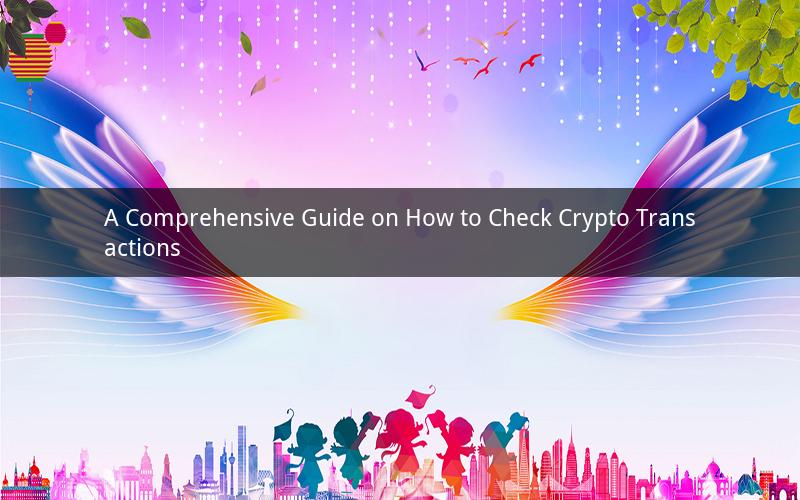
In the digital age, cryptocurrencies have gained immense popularity. With the rise of blockchain technology, individuals and businesses alike have started to explore the world of digital assets. One of the crucial aspects of dealing with cryptocurrencies is ensuring the security and transparency of transactions. This article aims to provide a detailed guide on how to check crypto transactions. By the end of this article, you will be well-equipped to track and verify your cryptocurrency transactions.
I. Understanding Crypto Transactions
Before diving into the process of checking crypto transactions, it is essential to have a basic understanding of how they work. A crypto transaction is a record of a transfer of digital currency from one wallet to another. Each transaction is stored in a blockchain, a decentralized ledger that keeps track of all transactions in a chronological order.
II. Steps to Check Crypto Transactions
1. Choose a Blockchain Explorer
A blockchain explorer is a tool that allows users to view and analyze transactions on a particular blockchain. To check your crypto transactions, you need to choose a reliable blockchain explorer. Some popular options include Etherscan for Ethereum, Blockchain.com for Bitcoin, and CoinGecko for multiple cryptocurrencies.
2. Access the Blockchain Explorer
Once you have selected a blockchain explorer, visit its website or open its application. You will be presented with a search bar where you can enter the address of the wallet or transaction hash.
3. Enter the Wallet Address or Transaction Hash
To check transactions related to a specific wallet, enter the wallet address in the search bar. The wallet address is a unique string of characters that identifies your cryptocurrency wallet. If you want to verify a particular transaction, use the transaction hash. The transaction hash is a unique identifier for a specific transaction, which can be found in the transaction receipt.
4. Review the Transaction Details
After entering the wallet address or transaction hash, the blockchain explorer will display the transaction details. This information includes:
- Transaction Hash: A unique identifier for the transaction.
- From Address: The address from which the transaction originated.
- To Address: The address to which the transaction was sent.
- Amount: The amount of cryptocurrency transferred.
- Gas Price: The fee paid for processing the transaction.
- Gas Limit: The maximum amount of gas that can be consumed by the transaction.
- Nonce: The sequence number of the transaction in the sender's transaction history.
- Block Number: The number of the block in which the transaction was included.
- Block Time: The time when the transaction was included in the block.
5. Verify the Transaction
To ensure the transaction is legitimate, compare the transaction details with the information you have. Check if the amount, addresses, and other details match your expectations. Additionally, you can verify the transaction by checking the block explorer's consensus. If the transaction is included in a confirmed block, it is valid.
III. Common Challenges in Checking Crypto Transactions
1. Transaction Delays
Due to network congestion or high gas prices, crypto transactions may take longer to be confirmed. It is essential to be patient and wait for the transaction to be included in a block.
2. Forks and Hard Forks
When a blockchain undergoes a fork, the chain splits into two or more chains. In such cases, some transactions may be lost or become invalid. To avoid confusion, it is crucial to stay updated on any potential forks or hard forks affecting the blockchain you are using.
3. Privacy Coins
Privacy coins, such as Monero or Zcash, use advanced cryptographic techniques to hide transaction details. In such cases, it is difficult to check the exact amount and addresses involved in a transaction.
IV. Frequently Asked Questions
1. Q: Can I check my crypto transactions on any blockchain explorer?
A: Yes, you can use any blockchain explorer that supports the cryptocurrency you are interested in. However, it is essential to choose a reliable and trusted explorer.
2. Q: Why are my transactions taking so long to be confirmed?
A: Transactions may take longer to be confirmed due to network congestion, high gas prices, or a low gas limit. In such cases, you can either wait for the congestion to clear or increase the gas price or limit.
3. Q: Can I cancel a crypto transaction?
A: Once a transaction is broadcasted to the network, it cannot be canceled. However, you can contact the recipient and ask them to reject the transaction if they have not yet confirmed it.
4. Q: How can I track a transaction if I have lost my wallet address?
A: If you have lost your wallet address, you can use the transaction hash to track the transaction. However, you will not be able to access the funds without the wallet address.
5. Q: Are crypto transactions secure?
A: Crypto transactions are generally secure, but they are not immune to risks. To ensure the security of your transactions, use reputable wallets, keep your private keys safe, and be cautious of phishing scams.
In conclusion, checking crypto transactions is a crucial step in maintaining the security and transparency of your digital assets. By following the steps outlined in this guide, you can verify your transactions and ensure they are legitimate. Always stay informed about the latest developments in the crypto space and use reliable tools to track your transactions.